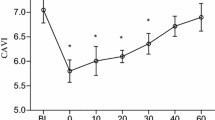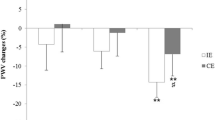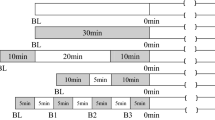Abstract
Purpose
To examine and compare the effects of acute moderate-intensity continuous and accumulated exercise with different intervals on arterial stiffness in humans.
Methods
Healthy young men (n = 16) participated in four trials in a randomized crossover design: complete rest control (CON), continuous exercise (CE, 30-min cycling), accumulated exercise with 20 min of interval (AE20, 2 × 15-min cycling) and accumulated exercise with 60 min of interval (AE60, 2 × 15-min cycling). Exercise was performed at intensity of 50 % heart rate reserve. Measurements of cardio-ankle vascular index (CAVI), an indicator of systemic arterial stiffness in humans, were performed at baseline (BL), immediately (0 min) and 60 min after exercise in exercise trials, and at corresponding time points in CON trial.
Results
CAVI remained unaltered throughout the procedure in CON trial (6.8 ± 0.1, 6.9 ± 0.1, 6.9 ± 0.2 at BL, 0 and 60 min, respectively). Similar CAVI reductions were observed in CE, AE20 and AE60 trials at 0 min compared to CON trial (P < 0.001 for CE, AE20 and AE60 vs. CON, respectively). Though CAVI in CE and AE60 trial returned to baseline at 60 min, the CAVI reduction at 60 min persisted in AE20 trial (P < 0.05 for AE20 vs. CON).
Conclusion
Compared to continuous exercise, accumulated exercise with appropriate short interval results in superior effects on systemic arterial stiffness in healthy young men, with arterial stiffness reduction for longer duration. When the interval is long, the acute superior effects of accumulated exercise on arterial stiffness disappeared.




Similar content being viewed by others
Abbreviations
- AE:
-
Accumulated exercise
- baPWV:
-
Brachial-ankle pulse wave velocity
- BL:
-
Baseline
- BMI:
-
Body mass index
- BP:
-
Blood pressure
- CAVI:
-
Cardio-ankle vascular index
- CE:
-
Continuous exercise
- CON:
-
Control
- DIA:
-
Diastolic blood pressure
- HIT:
-
High-intensity interval training
- HRR:
-
Heart rate reserve
- LB:
-
Left brachial
- RB:
-
Right brachial
- SYS:
-
Systolic blood pressure
References
Angadi SS, Weltman A, Watson-Winfield D, Weltman J, Frick K, Patrie J, Gaesser GA (2010) Effect of fractionized vs continuous, single-session exercise on blood pressure in adults. J Hum Hypertens 24(4):300–302. doi:10.1038/jhh.2009.110jhh2009110
Brandao Rondon MU, Alves MJ, Braga AM, Teixeira OT, Barretto AC, Krieger EM, Negrao CE (2002) Postexercise blood pressure reduction in elderly hypertensive patients. J Am Coll Cardiol 39(4):676–682 (pii):S0735109701017892
Eriksen L, Dahl-Petersen I, Haugaard SB, Dela F (2007) Comparison of the effect of multiple short-duration with single long-duration exercise sessions on glucose homeostasis in type 2 diabetes mellitus. Diabetologia 50(11):2245–2253. doi:10.1007/s00125-007-0783-0
Fisslthaler B, Dimmeler S, Hermann C, Busse R, Fleming I (2000) Phosphorylation and activation of the endothelial nitric oxide synthase by fluid shear stress. Acta Physiol Scand 168:81–88
Floras JS, Senn BL (1991) Absence of post exercise hypotension and sympathoinhibition in normal subjects: additional evidence for increased sympathetic outflow in borderline hypertension. Can J Cardiol 7(6):253–258
Garber CE, Blissmer B, Deschenes MR, Franklin BA, Lamonte MJ, Lee IM, Nieman DC, Swain DP (2011) American College of Sports Medicine position stand. Quantity and quality of exercise for developing and maintaining cardiorespiratory, musculoskeletal, and neuromotor fitness in apparently healthy adults: guidance for prescribing exercise. Med Sci Sports Exerc 43(7):1334–1359. doi:10.1249/MSS.0b013e318213fefb
Guimaraes GV, Ciolac EG, Carvalho VO, D’Avila VM, Bortolotto LA, Bocchi EA (2010) Effects of continuous vs. interval exercise training on blood pressure and arterial stiffness in treated hypertension. Hypertens Res 33(6):627–632. doi:10.1038/hr.2010.42
Hagberg JM, Montain SJ, Martin WH 3rd (1987) Blood pressure and hemodynamic responses after exercise in older hypertensives. J Appl Physiol (1985) 63(1):270–276
Haskell WL, Lee IM, Pate RR, Powell KE, Blair SN, Franklin BA, Macera CA, Heath GW, Thompson PD, Bauman A (2007) Physical activity and public health: updated recommendation for adults from the American College of Sports Medicine and the American Heart Association. Circulation 116(9):1081–1093
Heffernan KS, Jae SY, Echols GH, Lepine NR, Fernhall B (2007) Arterial stiffness and wave reflection following exercise in resistance-trained men. Med Sci Sports Exerc 39(5):842–848. doi:10.1249/mss.0b013e318031b03c
Hu Q, Zhu W, Zhu Y, Zheng L, Hughson RL (2012) Acute effects of warm footbath on arterial stiffness in healthy young and older women. Eur J Appl Physiol 112(4):1261–1268. doi:10.1007/s00421-011-2066-1
Ibata J, Sasaki H, Kakimoto T, Matsuno S, Nakatani M, Kobayashi M, Tatsumi K, Nakano Y, Wakasaki H, Furuta H, Nishi M, Nanjo K (2008) Cardio-ankle vascular index measures arterial wall stiffness independent of blood pressure. Diabetes Res Clin Pract 80(2):265–270. doi:10.1016/j.diabres.2007.12.016
Jones H, Pritchard C, George K, Edwards B, Atkinson G (2008) The acute post-exercise response of blood pressure varies with time of day. Eur J Appl Physiol 104(3):481–489. doi:10.1007/s00421-008-0797-4
Jones H, Taylor CE, Lewis NC, George K, Atkinson G (2009) Post-exercise blood pressure reduction is greater following intermittent than continuous exercise and is influenced less by diurnal variation. Chronobiol Int 26(2):293–306. doi:10.1080/07420520902739717
Kingwell BA, Berry KL, Cameron JD, Jennings GL, Dart AM (1997) Arterial compliance increases after moderate-intensity cycling. Am J Physiol 273(5 Pt 2):H2186–H2191
Liu S, Goodman J, Nolan R, Lacombe S, Thomas SG (2012) Blood pressure responses to acute and chronic exercise are related in prehypertension. Med Sci Sports Exerc 44(9):1644–1652. doi:10.1249/MSS.0b013e31825408fb
Liu S, Thomas SG, Sasson Z, Banks L, Busato M, Goodman JM (2013) Blood pressure reduction following prolonged exercise in young and middle-aged endurance athletes. Eur J Prev Cardiol 20(6):956–962. doi:10.1177/2047487312454759
Mc Clean CM, Mc Laughlin J, Burke G, Murphy MH, Trinick T, Duly E, Davison GW (2007) The effect of acute aerobic exercise on pulse wave velocity and oxidative stress following postprandial hypertriglyceridemia in healthy men. Eur J Appl Physiol 100(2):225–234
Mestek ML, Garner JC, Plaisance EP, Taylor JK, Alhassan S, Grandjean PW (2006) Blood lipid responses after continuous and accumulated aerobic exercise. Int J Sport Nutr Exerc Metabol 16(3):245–254
Millar PJ, Rakobowchuk M, McCartney N, MacDonald MJ (2009) Heart rate variability and nonlinear analysis of heart rate dynamics following single and multiple Wingate bouts. Appl Physiol Nutr Metab 34(5):875–883. doi:10.1139/H09-086h09-086
Naka KK, Tweddel AC, Parthimos D, Henderson A, Goodfellow J, Frenneaux MP (2003) Arterial distensibility: acute changes following dynamic exercise in normal subjects. Am J Physiol Heart Circ Physiol 284(3):H970–H978
Park S, Rink LD, Wallace JP (2006) Accumulation of physical activity leads to a greater blood pressure reduction than a single continuous session, in prehypertension. J Hypertens 24(9):1761–1770
Pescatello LS, Fargo AE, Leach CN Jr, Scherzer HH (1991) Short-term effect of dynamic exercise on arterial blood pressure. Circulation 83(5):1557–1561
Rakobowchuk M, Tanguay S, Burgomaster KA, Howarth KR, Gibala MJ, MacDonald MJ (2008) Sprint interval and traditional endurance training induce similar improvements in peripheral arterial stiffness and flow-mediated dilation in healthy humans. Am J Physiol Regul Integr Comp Physiol 295(1):R236–R242. doi:10.1152/ajpregu.00069.2008
Rakobowchuk M, Stuckey MI, Millar PJ, Gurr L, Macdonald MJ (2009) Effect of acute sprint interval exercise on central and peripheral artery distensibility in young healthy males. Eur J Appl Physiol 105(5):787–795. doi:10.1007/s00421-008-0964-7
Rakobowchuk M, Harris E, Taylor A, Cubbon RM, Birch KM (2013) Moderate and heavy metabolic stress interval training improve arterial stiffness and heart rate dynamics in humans. Eur J Appl Physiol 113(4):839–849. doi:10.1007/s00421-012-2486-6
Ronsen O, Kjeldsen-Kragh J, Haug E, Bahr R, Pedersen BK (2002) Recovery time affects immunoendocrine responses to a second bout of endurance exercise. Am J Physiol Cell Physiol 283(6):C1612–C1620. doi:10.1152/ajpcell.00242.2002
Ronsen O, Haugen O, Hallen J, Bahr R (2004) Residual effects of prior exercise and recovery on subsequent exercise-induced metabolic responses. Eur J Appl Physiol 92(4–5):498–507. doi:10.1007/s00421-004-1086-5
Shirai K, Utino J, Otsuka K, Takata M (2006) A novel blood pressure-independent arterial wall stiffness parameter; cardio-ankle vascular index (CAVI). J Atheroscler Thromb 13(2):101–107 (pii):JST.JSTAGE/jat/13.101
Smelker CL, Foster C, Maher MA, Martinez R, Porcari JP (2004) Effect of exercise intensity on postexercise hypotension. J Cardiopulm Rehabil 24(4):269–273 (pii):00008483-200407000-00012
Stuckey MI, Tordi N, Mourot L, Gurr LJ, Rakobowchuk M, Millar PJ, Toth R, MacDonald MJ, Kamath MV (2012) Autonomic recovery following sprint interval exercise. Scand J Med Sci Sports 22(6):756–763. doi:10.1111/j.1600-0838.2011.01320.x
Sugawara J, Otsuki T, Tanabe T, Maeda S, Kuno S, Ajisaka R, Matsuda M (2003) The effects of low-intensity single-leg exercise on regional arterial stiffness. Jpn J Physiol 53(3):239–241
Sugawara J, Maeda S, Otsuki T, Tanabe T, Ajisaka R, Matsuda M (2004) Effects of nitric oxide synthase inhibitor on decrease in peripheral arterial stiffness with acute low-intensity aerobic exercise. Am J Physiol Heart Circ Physiol 287(6):H2666–H2669. doi:10.1152/ajpheart.00077.2004
Tabara Y, Yuasa T, Oshiumi A, Kobayashi T, Miyawaki Y, Miki T, Kohara K (2007) Effect of acute and long-term aerobic exercise on arterial stiffness in the elderly. Hypertens Res 30(10):895–902 (pii):JST.JSTAGE/hypres/30.895
Thompson PD, Crouse SF, Goodpaster B, Kelley D, Moyna N, Pescatello L (2001) The acute versus the chronic response to exercise. Med Sci Sports Exerc 33(6 Suppl):S438–S445 (discussion S433–S452)
Tordi N, Mourot L, Colin E, Regnard J (2010) Intermittent versus constant aerobic exercise: effects on arterial stiffness. Eur J Appl Physiol 108(4):801–809. doi:10.1007/s00421-009-1285-1
Walther C, Gielen S, Hambrecht R (2004) The effect of exercise training on endothelial function in cardiovascular disease in humans. Exerc Sport Sci Rev 32(4):129–134
Wang H, Zhang T, Zhu W, Wu H, Yan S (2014) Acute effects of continuous and interval low-intensity exercise on arterial stiffness in healthy young men. Eur J Appl Physiol 114(7):1385–1392. doi:10.1007/s00421-014-2869-y
Willie CK, Ainslie PN, Taylor CE, Eves ND, Tzeng YC (2013) Maintained cerebrovascular function during post-exercise hypotension. Eur J Appl Physiol 113(6):1597–1604. doi:10.1007/s00421-012-2578-3
Woolf-May K, Kearney EM, Owen A, Jones DW, Davison RC, Bird SR (1999) The efficacy of accumulated short bouts versus single daily bouts of brisk walking in improving aerobic fitness and blood lipid profiles. Health Educ Res 14(6):803–815
Acknowledgments
This study was supported by National Natural Science Foundation of China (31371206) and Science and Technology Development Program of Beijing Municipal Commission of Education (KM201310029003).
Author information
Authors and Affiliations
Corresponding author
Additional information
Communicated by Massimo Pagani.
L. Zheng and X. Zhang have contributed equally to this work.
Rights and permissions
About this article
Cite this article
Zheng, L., Zhang, X., Zhu, W. et al. Acute effects of moderate-intensity continuous and accumulated exercise on arterial stiffness in healthy young men. Eur J Appl Physiol 115, 177–185 (2015). https://doi.org/10.1007/s00421-014-3008-5
Received:
Accepted:
Published:
Issue Date:
DOI: https://doi.org/10.1007/s00421-014-3008-5




